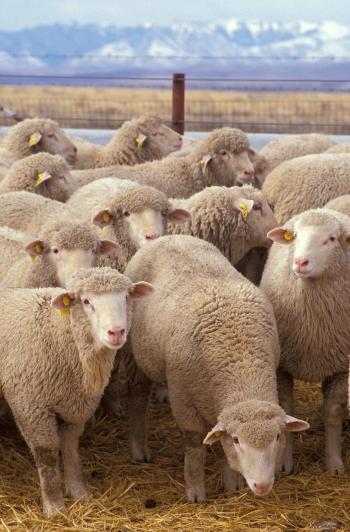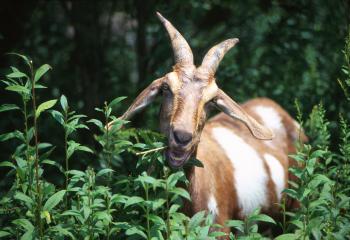Sheep and Goat Production in Arkansas
Sheep and goats can be raised with very little grain, which is advantageous at a time
when grain prices are on the rise. Photo Courtesy of USDA.
Sheep and goat production offers many advantages
- Because they are small, prolific and productive ruminants, they are well-suited to
grass-based and small-scale agriculture.
- Sheep and goats are relatively inexpensive animals to purchase and feed compared to
larger animals, a critical advantage for limited-resource farmers.
- Sheep and goats can be raised with very little grain, which is advantageous at a time
when grain prices are on the rise.
- Return on investment (ROI) is quick for sheep and goats because they reproduce at
a young age and have a high incidence of twinning, are marketed within 6 to 10 months
of birth, and can be raised economically on pasture.
- Due to their smaller size, they are not as intimidating or dangerous animals and are
good enterprises for women, youth, and aging farmers.
- As excellent weed and brush controllers, sheep and goats improve pastures and often
work synergistically with cattle and other livestock and cropping operations.
Similarities between goat and sheep production
- Both goats and sheep require similar feeds, fencing, housing and facilities, and health
care, including parasite management and predator control.
- Both produce meat that is desired by ethnic customers and by some health-conscious
or environmentally aware consumers (and by some who just know that lamb and goat taste
good).
- Market possibilities are similar.
- Both are generally inexpensive enterprises, and both are quick to mature and be ready
for breeding or market, and usually will have twins.
- Both improve pastures by eating under-used forages and depositing manure.
- There has been an increase in demand for sheep and goat meat, and artisan cheese makers,
and fiber businesses have also seen increased enthusiasm for their products, so there
are several options for using sheep and goats in profitable businesses.
Sheep and goats are not get-rich-quick enterprises
In addition to the questions about land, market, personal preference, economics—you
really have to first identify farm goals.
Advantages of these enterprises:
- Small size and low price for breeding stock = easy investment for a few starter animals
- Animals quickly reach maturity and reproduce, and quickly reach slaughter size on
forage alone = quick expansion of herd, quick payback of investment, low cost to produce
a saleable animal for market or breeding
- Multiple streams of income and easy combination with other enterprises, especially
cattle. Low investment in facilities and equipment = less debt and easier exit should
you need to leave the enterprise. Enjoyable animals = personal satisfaction and family
involvement
Disadvantages to sheep and goat enterprises:
- Fencing must be better than a cattle fence; this takes money and work
- Predators are a consideration and you must make provisions to protect the stock; a
good electric fence helps, but livestock guardian dogs (LGD) are often needed as well.
This means another animal to feed and provide health care, and manage; while most
LGD's are good, some are not, and this can be a hassle
- Health care for sheep and goats can be demanding, especially internal parasite management
- Because of their small size, income for selling market animals is low. This spreads
risk and makes them easy to market, but it also means you need to sell a lot of animals
to make significant income.
- In some situations, supplemental feed will be needed. You must strike a balance here,
providing good nutrition but keeping costs as low as possible.
Management programs for sheep and goats
In some situations, supplemental feed will be needed. You must strike a balance here,
providing good nutrition but keeping costs as low as possible. Photo Courtesy of USDA.
To be successful as a sheep and goat producer, you must have a sound management program
as the basis of your production plan. Observe your animals closely to keep individual
animals and the whole herd/flock healthy and productive. If the heath status of a
herd is compromised, your operation will not be efficient.
There are some human health risks when dealing with diseased animals.
While most diseases affecting sheep and goats do not pose any human health risks,
some are zoonotic and it is important to protect not only caretakers, but anyone else
that may come in contact with diseased animals. To recognize clinical signs of diseases
common to sheep and goats, it is important to be familiar with what is normal. As
a producer, you should assess the herd or flock's general health on a regular basis,
including vital signs, and body condition.
Normal Range for Goat and Sheep Physiological Parameters.
| Physiological Parameter |
Goat |
Sheep |
| Temperature, rectal |
101.5-103.5, F |
101.5-103.5, F |
| Heart Rate |
70-80 Beats per minute |
70-80 Beats per minute |
| Respiration |
12-25 per minute |
15-30 per minute |
| Rumen Movement |
1-2 per minute |
1-2 per minute |
| Estrous |
18-21 Days |
14-20 Days |
| Estrus |
48-72 Hours |
24-48 Hours |
| Gestation |
145-155 Days |
144-151 Days |
So much depends on management and marketing; it is a good idea to work out on paper
before starting an enterprise.
Having realistic expectations up front will save disappointment. Types of enterprises
that do offer larger incomes also require more expertise and labor and investment;
for example, dairy goats and show and breeding stock tend to have higher incomes but
also higher expenses.
Publications
For more information contact:
Dr. Dan Quadros
Asst. Professor - Small Ruminants
Phone: 501-425-4657
Fax: 501-671-2185
Email: dquadros@uada.edu
Office:
University of Arkansas System
Division of Agriculture
Cooperative Extension Service
2301 S. University Ave.
Little Rock, AR 72204
Livestock and Forage Links
Learn more about sheep and goat production

